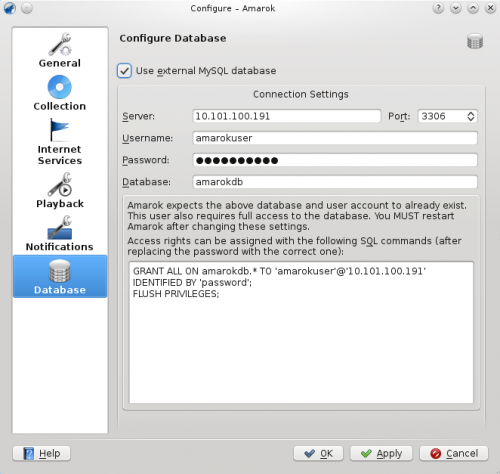Amarok/Manual/Samling/Ekstern database
Scanning af samling
Amarok 2.2 og senere understøtter en ekstern MySQL-database som motor.
Konfigurering af server
Installation af MySQL-server
Først skal du installere en MySQL-server. På en Debian-baseret distribution som Ubuntu kan du køre
sudo apt-get install mysql-server mysql-client
i en konsol for at installere den. Du vil blive bedt om at angive et password til databasens root-kontoen. Pakken mysql-client skal bruges til at udføre nogle af kommandoerne i dette dokument, men den er ikke nødvendig for at bruge Amarok.
Configure Database
Connect to the local database using
mysql -u root -p
You will be prompted for the password for MySQL's root user. You will get the
mysql>
prompt.
Create a new user amarokuser with the password amarokpass using the
CREATE USER ''''amarokuser''''@''''localhost'''' IDENTIFIED BY ''''amarokpass'''';
command. Amarok needs its own database, which is created with
CREATE DATABASE '''amarokdb''';
Give the new user access to the database by entering the
GRANT ALL ON '''amarokdb'''.* TO ''''amarokuser''''@''''%'''' IDENTIFIED BY ''''amarokpass'''';
command, where % is a wildcard to allow all hosts to connect to the database. Now use the
FLUSH PRIVILEGES;
statement to reload various internal caches used by MySQL. Finally
exit
closes the MySQL prompt.
By default the server can only be accessed by the local host. To change this you need to edit the file /etc/mysql/my.cnf and adjust the address near bind-address to the one your server listens on the network. 0.0.0.0 listens on all interfaces. After that you need to restart the server using
sudo service mysql restart
Configure Client
Open the configuration dialog by clicking . Enable the checkbox and enter the user data.

You need to restart Amarok so that the changes take effect.
Migrating from MySQL Embedded to MySQL Server
If you want to maintain the statistics, etc. that you have in the embedded MySQL database from before Amarok 2.2, you can do the following: First, start Amarok 2.2+ at least once to give the database a chance to update to the latest schema version.
Next, kill the running MySQL service
sudo /etc/init.d/mysql stop
and start a MySQL daemon from your ~/.kde4/share/apps/amarok directory (--defaults-file MUST be the first option!):
/usr/sbin/mysqld --defaults-file=`pwd`/my.cnf --default-storage-engine=MyISAM --datadir=`pwd`/mysqle --socket=`pwd`/sock --skip-grant-tables
The skip-grant-tables means you can use any password or username to connect to it. 'localhost' will not work, the MySQL client will try to use a Unix socket. Using 127.0.0.1 as the host makes it work. Some systems may restrict this access through apparmor or SELinux. They can be temporarily disabled with
sudo /etc/init.d/apparmor stop
Now, run mysqldump, passing in the -S option to specify the local socket. This will dump your old embedded DB out to a SQL file.
mysqldump -S sock amarok > amarok.mysql
You can then restart your MySQL service and load this SQL file into your MySQL server. You'll have needed to already run the GRANT statement above and create an Amarok database ("CREATE DATABASE amarok;"):
sudo /etc/init.d/mysql stop
mysql -u amarokuser -p amarok < amarok.mysql

